Three Birds Done, Macaw Supervising
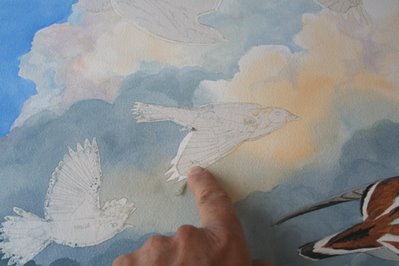 With the turnstone done, it's time to peel off some masking compound. I just roll it off with a clean finger, like rubber cement. Ideally, I've sealed the edges of the lightly tacky masking film well enough so no paint has crept under the edge. It's Day Two of painting now. I forget how many days I put into composing the thing before I could start painting. Let's just say many. That's the most time-consuming part, because that's where all the heavy thinking has to happen. Painting is something that either goes well or doesn't, but either way, it goes fast. Not to worry: this painting went well. So well, in fact, that I had up and painted the whole darn hooded warbler before remembering that I was supposed to be taking progress pictures. Well, heck, who wants to stop painting a hooded warbler to take pictures? I have to say, hooded warblers are pretty fast paints. I did his wings and tail first, then painted his yellow. The black hood went on right over the yellow and boom! he was done.
With the turnstone done, it's time to peel off some masking compound. I just roll it off with a clean finger, like rubber cement. Ideally, I've sealed the edges of the lightly tacky masking film well enough so no paint has crept under the edge. It's Day Two of painting now. I forget how many days I put into composing the thing before I could start painting. Let's just say many. That's the most time-consuming part, because that's where all the heavy thinking has to happen. Painting is something that either goes well or doesn't, but either way, it goes fast. Not to worry: this painting went well. So well, in fact, that I had up and painted the whole darn hooded warbler before remembering that I was supposed to be taking progress pictures. Well, heck, who wants to stop painting a hooded warbler to take pictures? I have to say, hooded warblers are pretty fast paints. I did his wings and tail first, then painted his yellow. The black hood went on right over the yellow and boom! he was done. 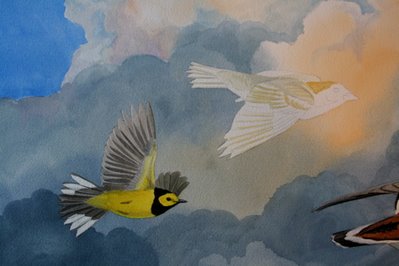 I made it sound like the cloud painting went really fast, and it did, but the whole time I was thinking about where the lightest parts of the birds would be, and I was toning the clouds so the darkest parts of the clouds would be where the lightest parts of the birds were. This makes them pop out against the background. See how the warbler's white tail spots stand out against the dark blue cloud top? Elsewhere, I let the bird kind of fade in, as on the upraised wing. You don't want it to look like a cutout. As you can see in the photo above, I had already started on a male bobolink before I stopped to shoot a photo. I'm painting all his pale parts first; his silvery back and cornsilk-yellow nape. That's the proper order in watercolor. Paint light to dark.
I made it sound like the cloud painting went really fast, and it did, but the whole time I was thinking about where the lightest parts of the birds would be, and I was toning the clouds so the darkest parts of the clouds would be where the lightest parts of the birds were. This makes them pop out against the background. See how the warbler's white tail spots stand out against the dark blue cloud top? Elsewhere, I let the bird kind of fade in, as on the upraised wing. You don't want it to look like a cutout. As you can see in the photo above, I had already started on a male bobolink before I stopped to shoot a photo. I'm painting all his pale parts first; his silvery back and cornsilk-yellow nape. That's the proper order in watercolor. Paint light to dark.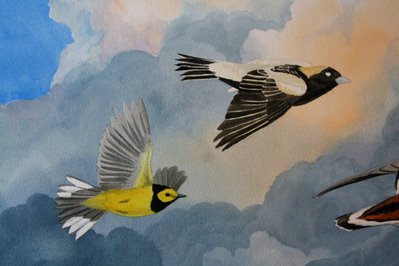 The black is blocked in, but the bird's far from done. Most of the magic in painting watercolor happens in the last few minutes, when you put little highlights of Chinese white on cheeks and bill and eye, and stroke a thin wash of it over the back to show light falling on it.
The black is blocked in, but the bird's far from done. Most of the magic in painting watercolor happens in the last few minutes, when you put little highlights of Chinese white on cheeks and bill and eye, and stroke a thin wash of it over the back to show light falling on it.A word about light: When I showed this to my group of artist friends (in jpegs, via email), Mike asked about the light source. Where's it coming from? I scratched my head. Good question. The birds are evenly lit overall, and there is no strong directional source of light. The overall effect of the painting is of diffuse light, a kind of weird, pre-storm light. And to be truthful, I wasn't really thinking that much about where the light was coming from. I had a lot of balls to juggle with this piece. I was most concerned with the local colors of the birds, with making a graphic statement with their markings. I wanted to show their colors as vividly as I could, without worrying too much about cast shadows or the direction of the light source.
So I said, "Well, it's kind of a fantasy flock, and I'm thinking about the lighting as being sort of like the lighting in a Celestial Seasonings tea box picture. Too good to be true. You know, pretty...OK, I didn't really think about the lighting very much."
And my friends all said, "That's OK. It works for us."
They're nice that way. But the funny thing is, I think in the end it did work out OK.
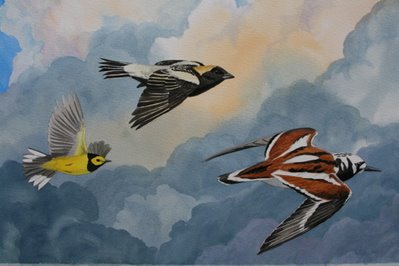 And the male bobolink joins his friends in the fantasy flock. I'm so happy with the way the peach flush in the cloud is working with the bobolink's colors.
And the male bobolink joins his friends in the fantasy flock. I'm so happy with the way the peach flush in the cloud is working with the bobolink's colors.Charlie moves in to preen the bobolink's wing feathers. He loves to watch me paint, and seems to know that the image depicts a bird. And he gets a huge kick out of climbing down off my shoulder and walking around on the art, checking out each new bird as it's painted.
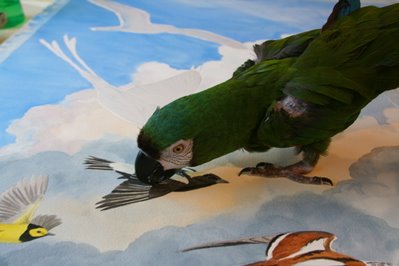
He's always most curious about the eyes. A macaw's tongue is very dry and rubbery, so there's little chance he'll smear anything once the paint dries, and it dries almost instantly in the dry air of winter. I have to spray down my palette every few minutes to keep the paint from hardening as I work.
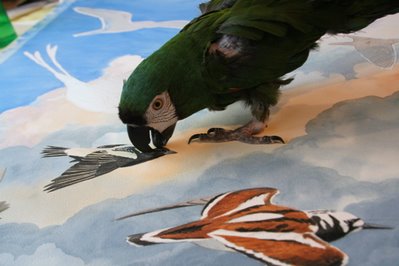 More birds tomorrow!
More birds tomorrow!Labels: bird painting, bobolink, Charlie the macaw, hooded warbler, masking compound, masking film






<< Home